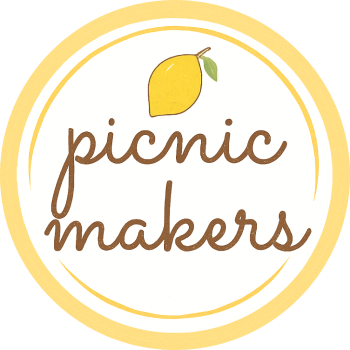You’re the person everyone turns to when it’s time to bring people together. You don’t have “event planner” in your title, but that’s exactly what you are. You’re planning something closer to home: a company picnic, a team offsite, a sunset gathering that reminds people why they enjoy working together in the first place.
And while everyone else just sees the result, you know how much intention it takes to make it feel that simple. This guide and open letter were made for you. A 25-step checklist to help you plan company events that are thoughtful and full of those quiet moments people remember long after the group photo is taken.
25 Steps for Corporate Event Planning
As we continue this open letter to you, we want you to know that we admire how you juggle calendars, coordinate details, and make it all feel seamless. You do it in between a hundred other tasks and definitely without a title that reflects how much heart you put into every gathering.
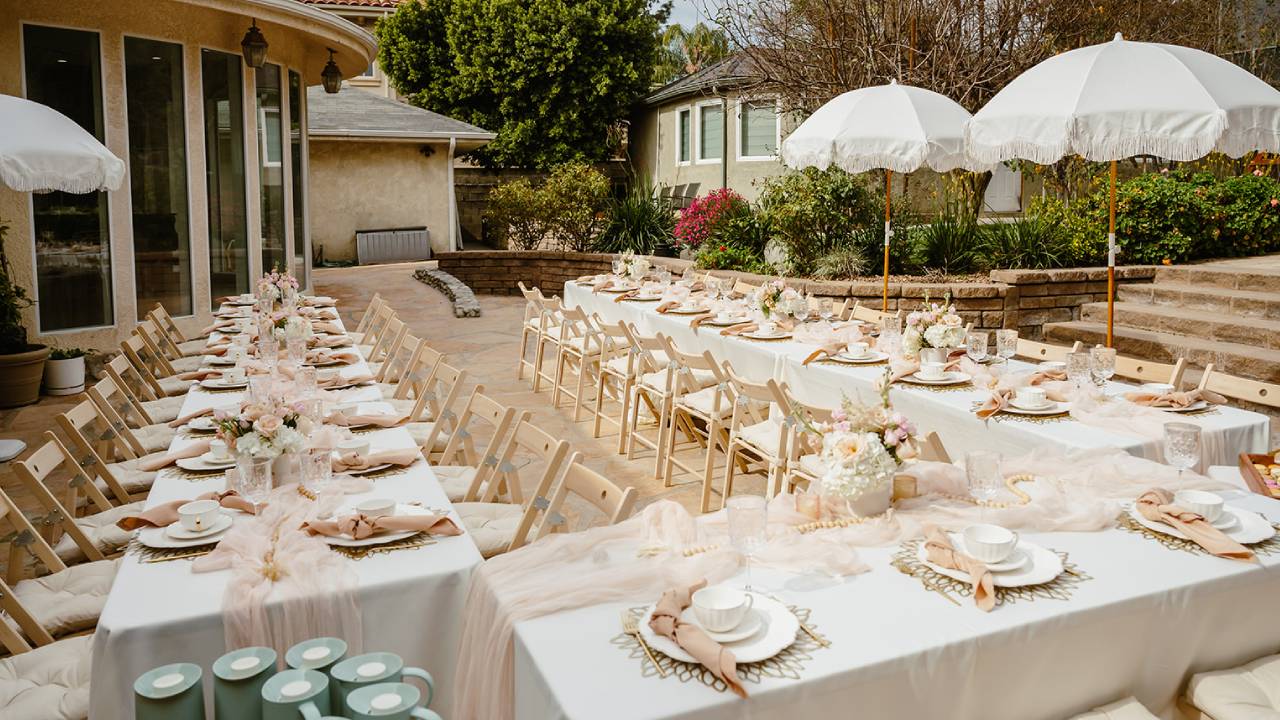
Copyright © Photo by Picnic Makers
This guide exists not to tell you what you already know, but to offer structure where it helps. You need something that understands what it’s like to want people to feel good being together. That’s what this is. A guide made for the way you already show up.
Define the Purpose of Your Corporate Event
This part of the planning process shows how the gathering should feel. Every choice that follows should be easier and more aligned with your goals. That’s the magic of mood-setting.
Step 1: Clarify the “why”
Start with purpose. What do you want this event to do for your team? Is it a moment to celebrate something big? A chance to reconnect after a stretch of remote work?
Or just a pause in the middle of a busy season to show your people that they matter? Defining the emotional goal sets the tone for everything else in your corporate event planning journey.
Step 2: Choose your moment
Time of day matters. For instance, a morning event might spark productivity and lead to good, coffee-fueled conversation. Golden hour brings warmth and a touch of ceremony.
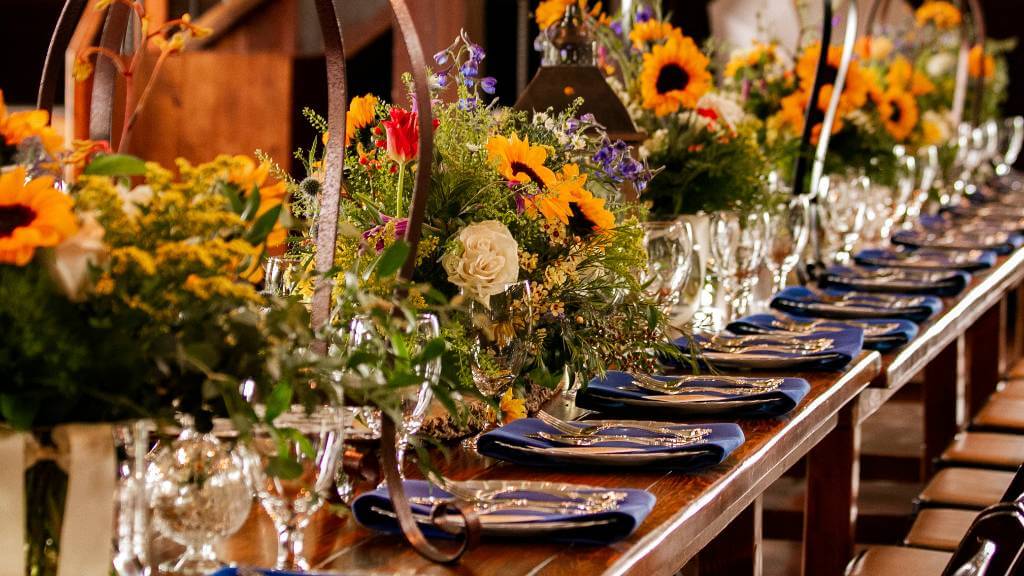
An evening fireside gathering feels slower, more reflective. The moment you choose shapes the rhythm and energy of the experience.
Planning Tip: The bespoke linens, artisanal centerpieces, and even the smallest details, such as artificial flowers and ambient string lights, will add to the setup while ensuring it aligns with your theme and makes a lasting impression on all employees and guests.
Step 3: Know who you’re planning for
While managing numbers on a guest list, you’re also planning a company event for actual humans. Who’s coming, and what will make them feel welcome? Is it a tight-knit team that already feels like a good fit?
A cross-functional mix that needs a light structure to bond? Designing with your guests in mind leads to moments that feel personal and intentional.
Step 4: Define the vibe
Here things start to take shape. Is your vision relaxed and cozy, with pillows on the grass and shared plates? Is it elevated and elegant, with long tables and soft lighting?
Maybe it’s something playful, like playing games, dancing, or listening to a DJ. Naming the vibe upfront gives every other detail a throughline.
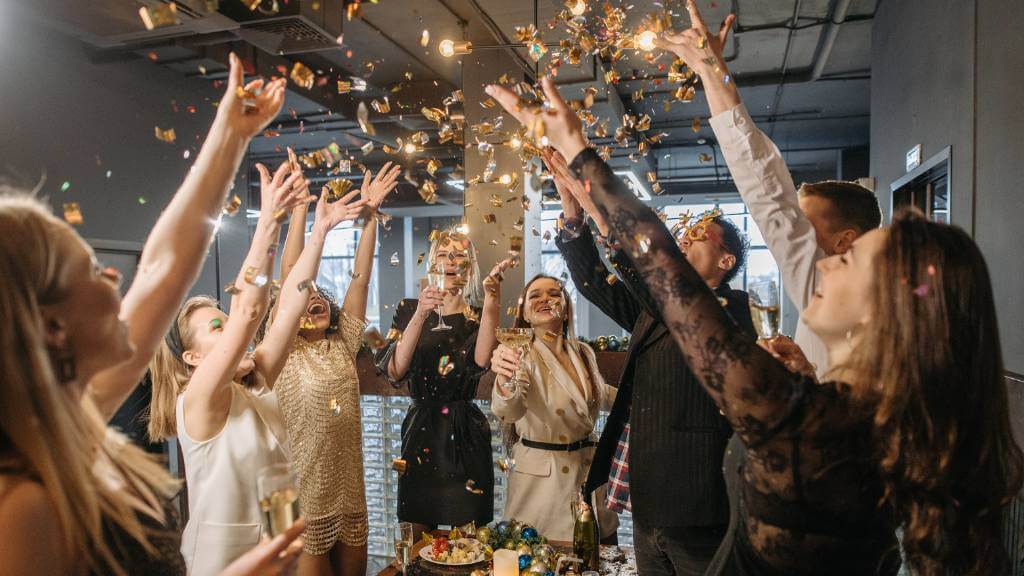
Here is what you can do to make your luxury picnic experience one of a kind:
- Group Mural Painting: Set up a large canvas or mural space where teams collaborate to create a piece that represents the company’s values or event theme.
- Creative Team-Building Exercises: Use the open space to implement various creative team-building activities for small groups, such as a scavenger hunt, relay races, or a group art project. Activities should focus on team spirit, communication, and problem-solving.
Why it`s great? These activities encourage social interaction and can be a sophisticated addition to your event. Here, employee appreciation day event ideas will help you with more inspiration to learn how to show gratitude towards them.
Step 5: Create a simple vision board
Pull a few images, color palettes, or even a line from a song that captures the feeling you’re after. It can live on Pinterest or a piece of scratch paper. Whatever it is, it becomes your anchor when decisions pile up.
Create a Thoughtful Event Plan Without the Stress

Now that the vibe is set, it’s time to bring your vision into something tangible. But hey, that doesn’t mean rushing into spreadsheets. With a few clear decisions up front, the rest flows more smoothly.
Step 6: Confirm your budget (and your stretch cushion)
This step needs clarity. Know your baseline. If possible, set aside a little buffer. Budgeting always comes with knowing where to put the most care.
Step 7: Choose a date that works for your people
This might sound simple, but timing can make or break your event. Avoid dates that bump up against big deadlines and high-stress seasons. The best business event planning happens when people want to be there, and that starts with when it’s happening.
Step 8: Get internal sign-off early
Nothing stalls momentum like waiting on approvals. Loop them in on the plan early. Share the vibe, the date, and the general direction. When people feel part of the vision, they’re more likely to support it quickly.
Step 9: Create a flexible planning calendar
Keep everything intentional. A shared planning calendar with gentle check-in points helps you avoid scrambling at the last minute. Drop in key dates: when invites go out, when vendors need confirmation, and when final numbers are due. It should give you more peace of mind.
Step 10: Organize your details in one shared doc
Keep it all in one place. Use a Google Doc or any other tool that works best for your workflow. In this way, you give yourself room to focus on the experience, rather than chasing scattered notes.
Corporate Picnic Decor and Venue Tips

Now that you know the why and the when, let’s talk about how it all comes to life. These next steps are where your gathering starts to take shape.
Step 11: Choose a venue or setting that supports the vibe
Start with feeling. What kind of environment brings your event to life? A backyard garden, a sunlit loft, a quiet outdoor space with room to spread out? We believe that the rest of your event planning checklist becomes a lot simpler when the setting matches the mood.
Step 12: Map the flow of the space
Walk through it in your mind. Where will people arrive? Where will they wander when they need a minute to themselves? A well-paced space turns a “company event” into something that feels natural and free-flowing. Believe us, that’s the secret to good corporate event management.
Step 13: Choose 1–2 intentional design elements
A few intentional touches go a long way. A signature color palette, soft linen textures, and a lounge corner with low seating and candles. Pick a couple of things that quietly tie it all together, details that make people feel cared for.
Step 14: Lock in rentals and experiences early
Book early and with a purpose. It’s easy to overdo it when you’re excited. Stick to what supports the experience, and balance style with budget so you can splurge where it counts.
Step 15: Create a simple visual guide
A lookbook doesn’t need to be fancy. Just a few photos, sketches, or notes that capture the tone. Share it with anyone helping you, so everyone is pulling in the same direction. It’s among the most underrated tools in any good event planning guide.
How to Choose the Right Food and Flow for Your Team
You don’t need a five-course menu to make people feel cared for. But you do need food that feels intentional, because what it’s served on shapes how people connect.
Step 16: Match the food to the feeling
The food should reflect the mood. If the gathering is relaxed and casual, lean into things like shared platters, picnic-style bites, or grazing boards. If it’s more focused or celebratory, think about something slightly elevated. It doesn’t have to be fancy. It just needs to feel right for the moment.

Step 17: Ask for dietary needs up front
Tacking this on at the last minute creates more stress than it’s worth. Add a line to your RSVP asking about allergies or preferences. It’s a small thing that shows a lot of care, and helps avoid awkward moments when someone’s left without options.
Step 18: Decide how the food will flow
Are people wandering and chatting, or sitting down together? Food stations encourage movement and mingling. Shared tables make things feel more intimate. Passed bites create rhythm and energy. However it’s served, make sure it supports the kind of gathering you’re trying to create.
Step 19: Don’t skip the setup details
You don’t need centerpieces or folded napkins, but a few thoughtful touches go a long way. Real plates. Linen instead of plastic. A stem or two of florals. Even if it’s outdoors, a well-set table makes people feel like they’re part of something more than just another company gathering.
Step 20: Add one small surprise
It doesn’t have to be big. Maybe it’s a signature drink named after an inside joke. A dessert station no one was expecting. Or a barista who remembers your team’s coffee orders. These little moments are the things people talk about afterward, and that’s what makes an event feel personal.
For an extra fun twist, why not incorporate a popcorn machine? It’s a crowd-pleaser that adds a touch of nostalgia and a sense of playfulness to your event. Plus, freshly popped popcorn is the perfect snack to enjoy during activities or while mingling with colleagues.
Final Touches: From Vendor Timing to Guest Experience
This is where the pieces start coming together. These final steps make sure the day feels as smooth as it looks.

Step 21: Finalize your vendor details and arrival times
Confirm the what, when, and where with every vendor. Double-check addresses, setup times, and who your day-of contact is. A quick call or email now saves a lot of frantic texting later. For anything that matters, make sure someone’s name is attached to each piece.
Step 22: Design a soft, tone-setting invite
Skip the standard calendar block. A thoughtful invite or email sets the stage. Include a few lines about what the gathering is for, what to expect, and any helpful tips (like dress code or parking). When you set the tone early, people show up in the right mindset, and that makes all the difference in company event planning.
Step 23: Create a “run of show” doc that works
Keep it clear and concise. What’s happening, when, and who’s in charge of what? Share it with anyone helping out.
Step 24: Don’t run the day alone, assign a co-pilot
Even if you’re the main planner, don’t carry it all on your shoulders. Have someone you trust as your point person for small questions, vendor arrivals, or wrangling the group for photos. A good co-pilot keeps the day from becoming a blur and lets you enjoy it, too.
Step 25: Prep a small guest gift or moment of thanks
This part is optional, but worth it. Maybe it’s handwritten thank-you notes, a tiny takeaway, or a short toast that acknowledges the people in the room. In corporate event planning, the quiet ending often leaves the loudest impression.
Day-Of Details and What Comes After
You’ve planned the mood, and now the day is here. The final moments of excellent company event planning should be soft, thoughtful, and a little magical.
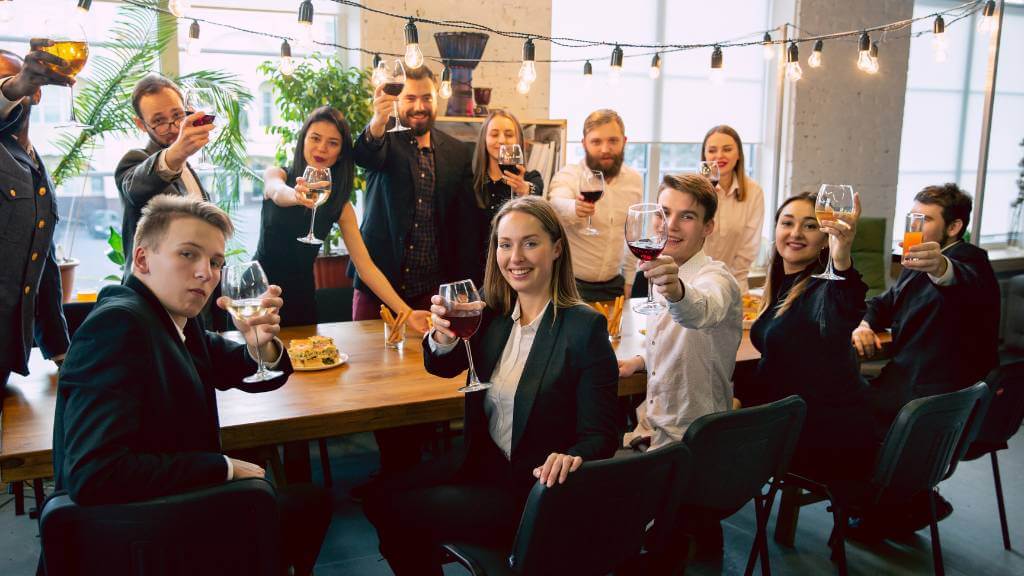
Arrive early. Walk the space slowly. Breathe.
Don’t rush in and start setting up the chairs. Take a quiet lap. Notice the light, the setup, the energy. This moment of calm helps ground you before anyone else arrives. It’s your chance to fully see what you’ve built before it fills with people.
Welcome guests with intention
PGreet people with eye contact and warmth. You’ve set the tone in your planning; now bring that same energy to your presence. This is the part of company event planning that matters just as much.
Keep it loose, let the magic happen.
You’ve done the prep. Trust it. Let conversations stretch, let the timeline breathe. If something runs a little late, or guests naturally drift toward something unexpected, let it happen. Great corporate event ideas often live in the in-between moments.
Capture the real stuff.
Assign someone to take candid photos. Ask them to catch the table before it’s touched, the spontaneous laughs, the in-between glances. These are the photos that will tell the true story of your event.

Send a thank-you that feels like you.
A short, warm message afterward means a lot. Include one photo, a sincere thank you, and a line or two about what made the gathering meaningful. It doesn’t need to be formal. Just real. A thoughtful follow-up is the final mark of great corporate event planning.
Tips for Smooth Corporate Event Logistics Planning 📅
From our experience in event planning, one of the most critical things for an outdoor event will be a weather contingency. At work, we checked the weather and created our materials. However, having a backup plan during inclement weather was a smooth process, and no hitch happened that would have ruined the whole event.

- Transportation arrangements: Ensure easy access to the venue for all attendees. Reserve a bus or ask the local taxi company to help you transport all the participants. Also, notice whether the members want to drive their vehicles to the event spot or need a solution.
- Weather contingencies: Plan for inclement weather to ensure the event runs smoothly.
- Comfortable seating: Provide seating that enhances attendees’ comfort.
- Adequate restroom facilities: Ensure restroom facilities are sufficient and accessible.
- Seamless audio-visual setups: Implement effective audio-visual solutions for presentations or entertainment. Outdoor projectors will ensure a good image, while the best outdoor Bluetooth speakers will ensure high-quality sound.
- Clear communication with vendors: Maintain open lines of communication for flawless execution.
- On-site coordination: ensure onsite team coordination from setup to breakdown.
The Final Touch That Makes It Memorable
The care you’ve shown in thinking through every moment of gathering matters. Your team may not always see the late-night planning tabs, but they’ll feel it when they show up to something that feels real.
And if at any point it starts to feel like too much, know we’re here for that too. Picnic Makers exists to support the kind of company events that make people feel something. So here’s to the next gathering you’ll bring to life. We hope it’s everything you imagined and just a little bit more.
With admiration,
The Picnic Makers Team
FAQs
How early should you start planning a company event?
You should begin planning 3-6 months in advance for small to mid-sized events and 6-12 months in advance for larger events so that you will have the time necessary to find and book a location and select your vendor’s services.
What’s the best way to set a budget for a corporate event?
List all the potential expenses, including those for a venue, entertainment, and catering. Allocate extra cost provisions for unforeseen expenses, such as around 10-20% of your total budget. If feasible, draw from past levels achieved in running different events.
How can you enhance attendee engagement at your event?
Use interactive technology, such as event apps, for networking and engagement. Plan for break-out sessions or interactive workshops depending on the event’s theme. Does personalization work where possible? For example, using a customized agenda will do that work.
How can feedback be collected and used after the event?
Send a digital survey within 24-48 hours after the event, while it’s still fresh in their minds. Use very directed questions about your objectives, event experience, and what could be improved. Leverage this to inform the next event.
What tips can you offer for selecting event vendors and partners?
Try to find experienced or specialized vendors at events related to your corporate event. Check and verify their references and reviews. Check whether the services they offer will suit your budget and quality. Negotiate the terms to avoid any surprises.
For those seeking to make their next corporate event truly stand out, embracing the concept of a luxury picnic may be the perfect strategy. Discover more company picnic ideas to inspire your next event.
Affiliate Disclaimer: This article contains affiliate links. We may earn a commission if you purchase through these links, at no extra cost to you.
